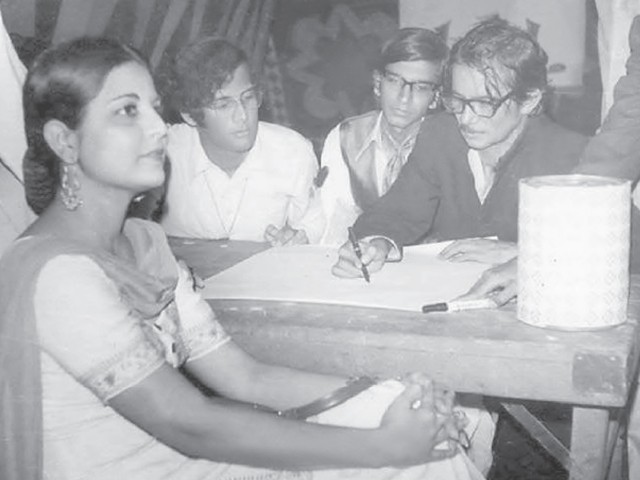Death anniversary of
Sadequain – The Ultimate Artist and Calligrapher.
Syed Sadequain Ahmed Naqvi was born in 1930 in Amroha and he died on
10th February in 1987 at the age of 57 years in Karachi, Pakistan.
Sadequain was a world renowned Pakistani Art legend. He was best known for his independent real creative art and novice trends in Islamic Calligraphy. His original superb themes and huge murals dwarf many and some are still regarded as matchless in the world. His international recognition was due to introduction of new initiatives and trends in art and particularly poetic calligraphy which was almost nonexistent then.
He was a self-made, self taught painter, completely untraditional and above all, shows no signs of being inspired by any other master of art who lived before him or at his time.
Sadequain received well deserved decorations.
1960 – Government of Pakistan — “ Tamgha-e-Imtiaz”
1961 – Government of France — “Biennale de Paris”
1962 – President of Pakistan — “President’s Medal of Honor”
1975 – Government of Australia — “Cultural Award”
1980 – Government of Pakistan — “Sitara-e-Imtiaz”
Sadequain was a master genius of his own self-inspired school of thought and different from other great artists like Michael Angelo and Leonardo de Vinci. This fact was proved later by the performance presented by him in his early life. Like many other masters he too was completely obscure, until he was noticed, hand –picked and appreciated by the notable lover of arts Mr. Hussain Shaheed Suhrawardy. It is natural that a true genius sees the limelight once and then the “limelight” itself focuses on him and seldom misses him till the last day. He had stepped into the open world to breathe and expose his talents independently – and this he did with utmost honesty without being distracted by worldly glamour.
Sadequain projected his abilities and hidden talents by his masterly performance in his mid twenties. This comparative quicker recognition laid the foundation and encouraged him to present his true inner feelings in his artworks. Soon he created his own independent place in the world that remained still unmatched, in certain aspects, during his lifetime and even after. He was only 30 years when he received his first award in 1960 and 32 years when the French Government decorated him.Sadequain was one of the most hard-working artists that the world has seen. His non-stop untiring career was very unusual for all his critics too. Wealth had least attraction for him and avoided to paint for the rich. He preferred to gift away thousands of his art productions instead of selling. Numerous works were stolen and he least bothered about them.
He believed in realism and lycricism. He was miles away from imaginary fairytale, flower and fona themes and stuck to basic worldly realities till his last day. The Novice style of his presentation of Quranic and Poetic verses created an everlasting impact on Pakistani Art. The non-existant calligraphy has changed into a culture and this new introduction is still flourishing beyond bounds and spreading inspiration worldwide, even after a quarter century beyond his death. Now his style and his paintings are also being copied extensively in Pakistan. Infact this piracy is promoting his school of thought, unnoticed.
Sadequain once saw a tough cactus tree growing and flourishing in a desert. He was spiritually impressed by the difficult lifestyle in extreme tough surroundings of this self-growing plant. This impression is often reflected in Sadequain’s tough and rugged human figures that seem unnatural, but actually he intended to expose the rigid uneven patterns of the life spent by the deprived. His works and productions are discernable and can easily be singled out. His unique independent style, objective concepts and presentation modes cannot be stolen by just putting on new names – but can only be copied along with his signatures.
The following are a few of his memorable works and exhibitions;
1954 – Solo Exhibition in Quetta, Pakistan
1955 – Mural at Jinnah Hospital, Solo Exhibition at Frere Hall and at residence of Mr. Suhrawady.
1961 – Mural at State Bank of Pakistan, (62 x 10ft) titled as “Treasures of Time”. This mural illustrates human scientific development from Socrates to Einstein and Muhammed Iqbal. He was invited to France to illustrate French Nobel Prize Winning writer Albert Camus.
1963 – Several Exhibitions in USA
1963 – Illustrated “Le Etranger” in France
1967 – Mural at Mangla Dam Power House (200 x 30ft) titled as “Saga of Labor” This mural lime lights the importance of the working class and its contributions in a society. Completed in 3.5 months only.
1968 – Mural at Punjab University Library, titled as “Quest of Knowledge”
1969 – Calligraphic redention of “Sura-e-Rehman”
1973 – Murals at Lahore Museum entrance Hall and others (100 x 35ft) titled as “Evolution of Mankind”
1974 – Exhibitions in Middle East and Eastern Europe.
1976 – TV. Series “Mojiza-e-fun” on Sadequain Art.
1977 – Illustrated Mirza Ghalib (Indian Poet)
1979 – Mural in Abu Dhabi power house (70 x 12ft)
1981 – Murals painted at Aligarh (70 x 12ft), Banaras (70 x 12ft), Hyderabad and Geological Institute of Delhi, India (70 x 25ft)
1985 – Illustrated Faiz Ahmed Faiz (Pakistani Poet)
1986 – Mural at Frere Hall titled as “Arz-o-Samawat” (heaven and earth)
Ibne Insha & Sadequain in 1970's ....
































